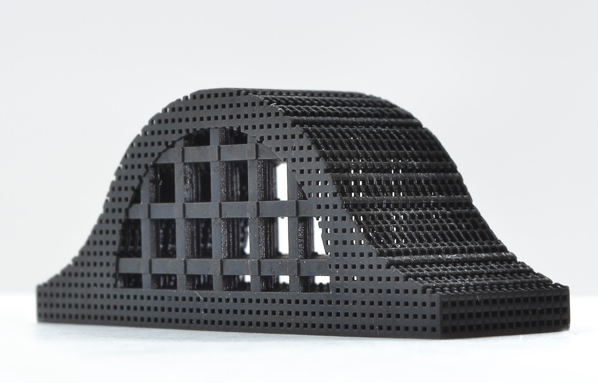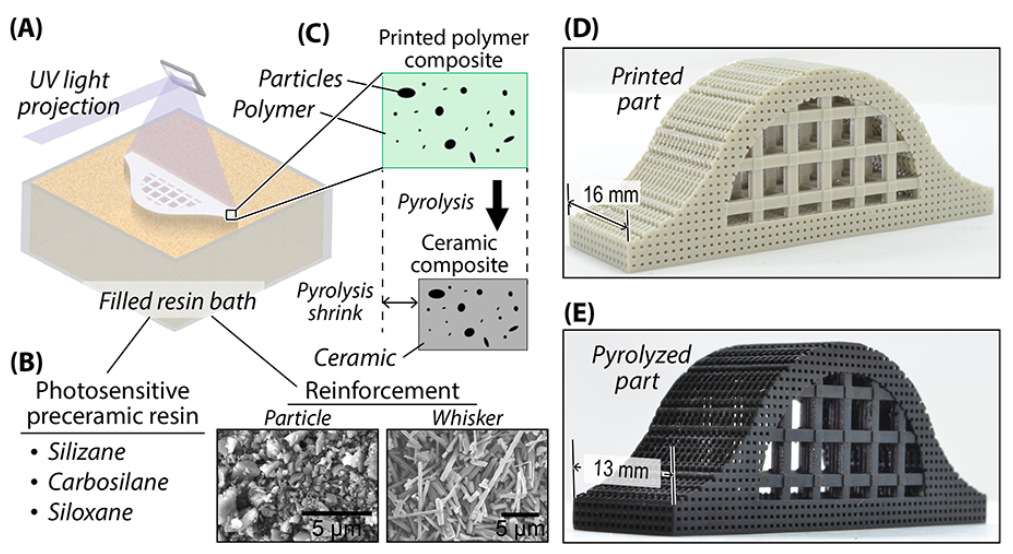Researchers from HRL Laboratories, a research center owned by General Motors and Boeing, have developed a novel method of 3D printing parts using fracture-resistant Ceramic Matrix Composites (CMCs).
The HRL team developed a novel siloxane-based preceramic resin, reinforced it with inert particles, then used an extreme heating process called pyrolysis to convert it into silicon oxycarbide (SiOC). The resulting glassy material featured enhanced durability, and according to the research team, it could be used within new energy sensitive areas such as propulsion, energy generation, and chemical processing.
“The challenge we addressed in this project was integrating this toughening solution with our 3D printing process,” said Mark O’Masta, HRL’s lead researcher on the project. “We can now add these reinforcements in large-volume fractions to significantly toughen our 3D printed ceramic parts.”
“We’ve essentially made a brittle monolithic material into a durable composite. As an extra benefit, adding reinforcements relaxed some of the processing constraints.”

Expanding upon the applications of 3D printed ceramics
Ceramic components typically possess excellent resistance to corrosion and wear, and their unique properties lend them potential applications in high-temperature areas, but shaping them has proved problematic. Using fragile ceramics to fabricate complex parts with narrow geometries, can also cause pressures to build on their internal cracks and voids, which sometimes leads to disastrous failures.
“All ceramic parts, whether traditionally processed or 3D printed, have small defects, such as tiny voids, that arise during processing, handling, and service,” explained O’Masta. “The problem is that when stress is applied to that region, the defect can become an uncontrolled crack, which results in catastrophic failure of the entire part.”
Ceramic 3D printing technologies may still be in their relative infancy, but commonly-used techniques are already starting to emerge to get around this issue. A mixture of Direct Ink Writing (DIW) and Fused Deposition Modelling (FDM) approaches have been attempted, but more commonly, photopolymerization (SLA) is utilized to cure polymer-infused feedstock.
In each of these existing processes, the printed ‘green’ part is subjected to a two-step heat treatment that removes the polymer (debinding), before the ceramic particles are sintered. Now recent research has yielded an alternative approach, which involves 3D printing using siloxane-based resins instead, before turning them into SiOCs via pyrolysis.
This emerging ceramic fabrication technique eliminates the lengthy debinding and sintering steps, potentially making it a faster alternative to conventional ceramic printing processes. In order for this new temperature-based approach to work effectively though, a ceramic material needs to be developed that addresses the material’s low intrinsic toughness, and prevents poor particle fusion.

HRL Labs’ novel approach to 3D printing ceramics
In order to get around the inherent fragility of ceramics, the HRL team developed a novel process that required the development of a ceramic fiber reinforced-CMC. The researchers formulated their new resin using a mixture of photoinitiators and a silicon oxycarbide (SiOC) material, which contained dispersed inert ceramic particles.
Leveraging a Prodways ProMaker L5000 industrial printer, the researchers then fabricated a series of 1.25 (t) × 2.5 (h) ×15 (l) mm3 samples with the aim of assessing and optimizing their formula. Following a number of characterization tests, the team identified a high-level of particle dispersion, but also a curious behavior in the reinforced parts’ tensile strength.
As it turned out, the thicker samples were more prone to cracking than their thinner counterparts, and through this discovery, the HRL team identified a “sweet spot” in the level of reinforcement they could achieve. Adding too much of the reinforcing element would surpass its “packing limit” and weaken the part, while not including enough, could leave the ceramic vulnerable to fracturing.
Having worked on their technique since 2016, the research team believes that they may have finally created a well-dispersed, reinforced ceramic with reduced shrinkage after heating. Products printed using the enhanced material featured three times greater wall thickness and toughness of over 3 MPa, leading the HRL team to conclude that new, more complex, ceramic parts could now be possible.
“Through a detailed study and careful inspection for defects using light and electron microscopy, we were able to identify the right processing conditions,” concluded Ekaterina “Katya” Stonkevitch, a co-author author of HRL’s study. “With that information, we discovered that we could print parts thicker than before.”
Ceramic innovations within 3D printing
Although ceramic additive manufacturing is still being fully optimized for high-stress end-use applications, a number of firms have already commercialized the technology.
Scientists from the Fraunhofer Institute for Ceramic Technologies and Systems (IKTS) have developed a Multi Material Jetting (MMJ) system that’s capable of producing reinforced ceramic parts. The new machine fuses materials such as metals and ceramics together in order to harness their combined properties.
Netherlands-based 3D printer manufacturer Admatec has launched a modular new DLP 3D printer that’s also compatible with ceramics: the Admaflex 300. The system has been designed to fulfill the needs of those in the investment casting industry for producing large-scale alumina parts and silica cores or shells.
Elsewhere, Material jetting specialist XJet has partnered with Straumann, to advance the capabilities of its ceramic 3D printing technology for dentistry applications. By adopting XJet’s additive manufacturing systems, Straumann has been able to design and fabricate dental parts with complex geometries using the typically brittle material.
The researchers’ findings are detailed in their paper titled “Additive manufacturing of polymer‐derived ceramic matrix composites,” which was authored by Mark R. O’Masta, Ekaterina Stonkevitch, Kayleigh A. Porter, Phuong P. Bui, Zak C. Eckel, and Tobias A. Schaedler.
To stay up to date with the latest 3D printing news, don’t forget to subscribe to the 3D Printing Industry newsletter or follow us on Twitter or liking our page on Facebook.
Are you looking for a job in the additive manufacturing industry? Visit 3D Printing Jobs for a selection of roles in the industry.
Featured image shows one of the HRL team’s 3D printed ceramic composite-reinforced structures. Image via HRL Laboratories.



